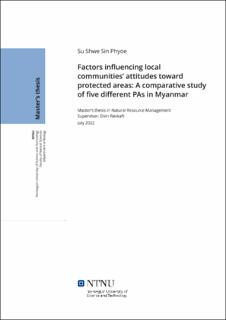| dc.description.abstract | Abstract
Protected areas (PAs) are one of the most effective mitigation strategies to reduce anthropogenic pressures on biodiversity and natural resources. However, the rights and involvements of local communities living in the vicinity of PAs have often been neglected in the PA management, which has created conservation conflicts and failures of conservation targets. Therefore, understanding local attitudes toward PAs becomes important in developing conservation strategies. To understand people-park interactions better, and to balance a trade-off between conservation and development, comprehensive attitudinal studies are required. This study aims to assess the community attitudes toward five PAs in Myanmar; Chatthin Wildlife Sanctuary (CWS), Indawgyi Wildlife Sanctuary (IWS), Moeyungyi Wetland Wildlife Sanctuary (MWWS), Natma Taung National Park (NTNP) and Shwe Set Taw Wildlife Sanctuary (SWS), by investigating how sociodemographic, resource dependency, benefit gained from PAs and individual PA characteristics influence community attitudes toward PAs and conservation support. Questionnaire surveys were conducted with 1099 local households. Results showed that people who live close to the PAs were more dependent on the PA resources for their livelihoods than people from intermediate and further distances. Those who depended on the resources acknowledged the PA benefits more than people who were less dependent on such resources. Furthermore, those who recognised the benefits expressed more positive attitudes towards the PAs. Occupation also played an important role in determining the attitudes as fishermen had more positive attitudes than farmers. Men were more aware of the conservation challenges and had more conservation knowledge than did the women. People who had previous experience in conservation, or had conservation knowledge, were more willing to conserve. Results also indicated that spatial differences and PA characteristics (PA shape, PA size, PA age and IUCN categories) could also influence the attitudes. This study suggests that the importance of multiple socioeconomic factors in developing future PA conservation strategies, while recognising context dependent nature of local attitudes, driven by PA characteristics and management.
Keywords: Attitudes, benefits, characteristics, conservation, dependency, protected areas. | |
